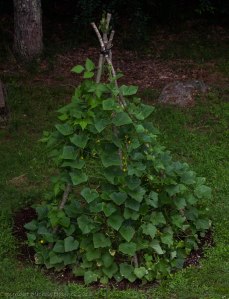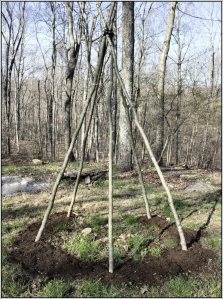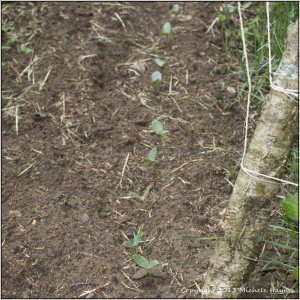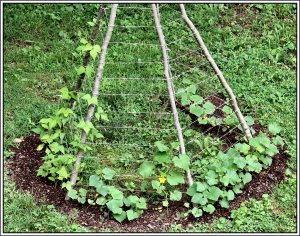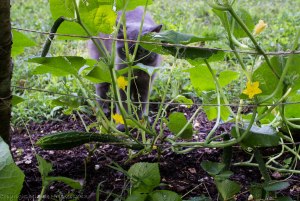I have a vision for this year’s garden and it includes a LOT of vining black beans growing as a backdrop for other crops. I have a lot of flower garden space that is not being utilized well since I can’t afford to buy shrubs at this time. I also want to grow a decent amount of black beans this year. Since I have a raised ranch style of home, the space beneath the overhanging part of the front gets neither sunlight nor rain. Honestly, it is where the chickens dusted when we had chickens and where the cats do their thing when there is snow covering the rest of creation. A big part of building any kind of garden structures is accessibility. Because of joint damage from Lyme disease, and chronic pain and fatigue, I prefer and need raised beds so I can sit while gardening. Gardening with disabilities is a real challenge.

Front garden: cucumbers growing on a pear branch trellis which did not hold up well to a tropical storm
Last summer I had a vague idea of putting trellises of some sort in front of this overhang, at least on the southeastern portion of the house and training black beans so they can grow up and provide not only a beautiful green wall but lots of beans as well. Now comes the point where I must decide what kind of structure I will create for these beans. I could make something as simple as a string trellis made from twine supported by a large rectangular wooden frame, purchase lattice from the hardware store, or create some kind of organic lattice from young trees and vines. I have a lot of wild grapes on my property, so I think I could harvest plenty of vine for that purpose. Garden Desk has a blog post on a rectangular wooden frame holding a trellis material.
One garden structure that did well last year was a large trellis teepee made from saplings I cut on my property. I especially loved this structure because I could stand upright inside to harvest cucumbers (and later beans). The dog loved going inside and the plants, especially the cucumbers, loved the tall structure producing a lot of cucumbers. The beans thrived in the fall when they decided to finally produce beans (I still haven’t figure out what in the world was wrong with the bean plants that they didn’t produce all summer long). Building a teepee trellis large enough for a disabled adult is a great option. The only way to make this even better would be to create a circular raised bed and place the teepee in the center allowing the disabled gardener to sit while working in the soil and preserving the ability to walk/wheel inside. Hmmmm, this gave me some ideas about using concrete blocks (or natural stone) to hold soil creating a keyhole-type structure with access in the center. It would require a much shorter teepee, though, so that fruit can be reached.
I decided to do a little online research and found some great ideas for more accessible garden structures.
Three Garden Structures You Can Build from Vegetable Gardener. I don’t think the tomato cage is beefy enough for indeterminate tomato plants, but it could certainly work for determinate tomatoes and pepper plants (which I discovered also need cages or supports of some kind). I also like the elongated bean teepee design.
Wire Arched Supports for Beans and Cucumbers from Get Busy Gardening blog. This is great for someone who can get beneath the wire structure. I need to either stand or sit to garden. Although I can bend over from the waist I cannot kneel or squat and sitting on the ground is very painful for me. Maybe a stool placed beneath this structure would work or ensuring that it is tall enough that a person in a wheelchair could access that space.
Wheelchair Gardens are also great for elderly people or someone like me who has chronic pain and fatigue and cannot kneel on the ground without pain and difficulty rising. I especially like the idea of a lettuce table for lettuce and spinach. Great blog post from Eat Live Grow Paleo.
15 Reasons to build an herb spiral by Jean Bardeau from Natural News. Although the lowest level might be inaccessible, it would be possible to create the herb spiral leaving the lowest part out with a higher spiral overall.

Squash trellis would work with any kind of vining plant especially if placed in two parallel raised beds
Here is an ingenious way to build a teepee trellis, or as I figured out, flat trellis pieces that can be attached to the house for my desired black beans. And I could make these out of saplings and branches using cord to strap them together. Interesting and a good possibility for my purposes. Made large enough, these could be accessed by an individual in a wheelchair if they straddle two raised beds. The plans are available for free at Organic Gardening online.
Building more permanent, sturdy garden structures or temporary, movable garden structures will be an ongoing project for me this year. I hope to get my 13 year old involved in gardening. He used to be my little nature boy, so I want to awaken that sleeping part of his curious nature (if I can get him away from the computer — blah).
Happy Gardening!
My front garden was dug in the sloping ground. It is not easy for me to work since I cannot kneel or sit on the ground easily. I think I will add walls on the downward side to that I can sit on the edge while raising the beds higher off of the ground.
